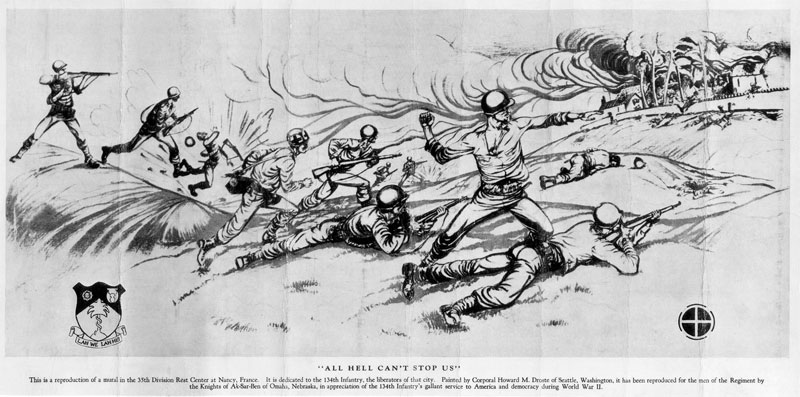35th Infantry Division (U.S. Army) WWII
Nickname: Santa Fe.
Shoulder patch: Santa Fe crossa white cross within a white wagon wheel on blue field.
Activated: 23 December 1940 (National Guard Division from Kansas, Missouri and Nebraska).
Overseas: 12 May 1944.
Campaigns: Normandy, Northern France, Rhineland, Ardennes-Alsace, Central Europe.
Days of combat: 264.
Distinguished Unit Citations: 6.
Awards: MH-1 ; DSC-44 ; DSM-1 ; SS-688 ; LM-10; DFC-1 ; SM-22 ; BSM-3,435 ; AM-133.
Commanders:
Maj. Gen. R. E. Truman (December 1940-October 1941) Maj. Gen. William H. Simpson (October 1941-April 1942) Maj. Gen. Maxwell Murray (May 1942-January 1943) Maj. Gen. Paul W. Baade (January 1943 to inactivation).
Returned to U. S.: 10 September 1945.
Inactivated: 7 December 1945.
Combat Chronicle (World War II)
The 35th Infantry Division arrived in England, 25 May 1944, and received further training. It landed on Omaha Beach, Normandy, 5-7 July 1944, and entered combat 11 July, fighting in the Normandy hedgerows, north of St. Lo. The Division beat off 12 German counterattacks at Emelie before entering St. Lo, 18 July. After mopping up in the St. LO area, it took part in the offensive action southwest of St. Lo, pushing the Germans across the Vire, 2 August, and breaking out of the Cotentin Peninsula. While en route to an assembly area, the Division was “flagged off the road,” to secure the Mortain-Avranches corridor and to rescue the 30th Division’s “Lost Battalion,” 7-13 August 1944. Then racing across France through Orleans and Sens, the Division attacked across the Moselle, 13 September, captured Nancy, 15 September, secured Chambrey, 1 October, and drove on to the German border, taking Sarreguemines and crossing the Saar, 8 December. After crossing the Blies River, 12 December, the Division moved to Metz for rest and rehabilitation, 19 December. The 35th moved to Arlon, Belgium, 25-26 December, and took part in the fighting to relieve Bastogne, throwing off the attacks of four German divisions, taking Villers-laBonne-Eau, 10 January, after a 13-day fight and Lutrebois in a 5-day engagement. On 18 January 1945, the Division returned to Metz to resume its interrupted rest. In late January, the Division was defending the Foret de Domaniale area. Moving to Holland to hold a defensive line along the Roer, 622 February, the Division attacked across the Roer, 23 February, pierced the Siegfried Line, reached the Rhine at Wesel, 10 March, and crossed, 25-26 March. It smashed across the Herne Canal and reached the Ruhr River early in April, when it was ordered to move to the Elbe, 12 April. Making the 295-mile dash in 2 days, the 35th mopped up in the vicinity of Colbitz and Angern, until 26 April 1945, when it moved to Hanover for occupational and mopping-up duty, continuing occupation beyond VE-day. The Division left Southampton, England, 5 September, and arrived in New York City, 10 September 1945.
Origins of the 79th Division, (U.S. Army) WWI
The 79th Division consisted of the 313th, 314th, 315th, and 316th Infantry Regiments. The 315th and 316th Regiments together formed the 158th Infantry Brigade (p. 21).
The order creating the various units of the 79th Division was issued by the War Department on 3 August 1917, and the 315th Infantry Regiment was provisionally organized on 26 August 1917, and then permanently organized on 21 September 1917 (p. 19). In the fall of 1917 t…he strength of an infantry regiment was set at 103 officers and 3,652 enlisted men (p. 32-33).
Immediately following its declaration of war against the Imperial Government of Germany (on 6 April 1917), the U.S. Government rented some 15 square miles of land in Anne Arundel County, Maryland, which the War Department proposed making into a national army cantonment to receive recruits from eastern Pennsylvania, Maryland and the District of Columbia. The cantonment was called “Camp Meade” [now Fort Meade, Maryland], in honor of the U.S. Civil War’s General George Meade.
The 315th Infantry (79th Division, United States Army) was a combat unit of the American Expeditionary Forces in France. The 315th Infantry was made up of three battalions and four special units:
•First Battalion: Companies A-D…
•Second Battalion: Companies E-H
•Third Battalion: Companies I, K-M
•Special Units: Headquarters Company, Machine Gun Company, Supply Company, and Medical Detachment.
We as a group will be portraying 79th Division, 315th infantry Regiment, 2nd Battalion H Company.
2nd Battalion, 8th Marines (USMC) WWII
2nd Battalion, 8th Marines was activated on 1 April 1940 in San Diego as the 2nd Battalion 8th Marine Regiment and assigned to the 2nd Marine Brigade. The 2nd Marine Brigade was re-designated 1 February 1941 as 2nd Marine Division. During World War II, the battalion participated in the Battle of Guadalcanal, Battle of Tarawa, Battle of Saipan, Battle of Tinian and the Battle of Okinawa. Following the surrender of Japan, the battalion deployed to Nagasaki, Japan in September 1945 as part of the occupation. They remained in Japan in this capacity until they redeployed back to Marine Corps Base Camp Lejeune, North Carolina in June 1946. The battalion was deactivated on 13 November 1947 as part of the post-war drawdown of forces.



